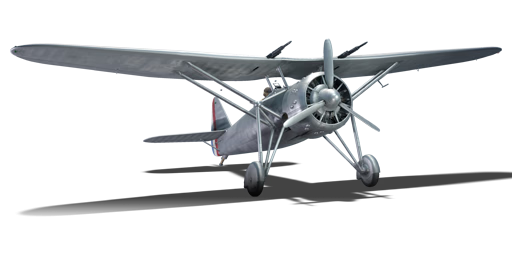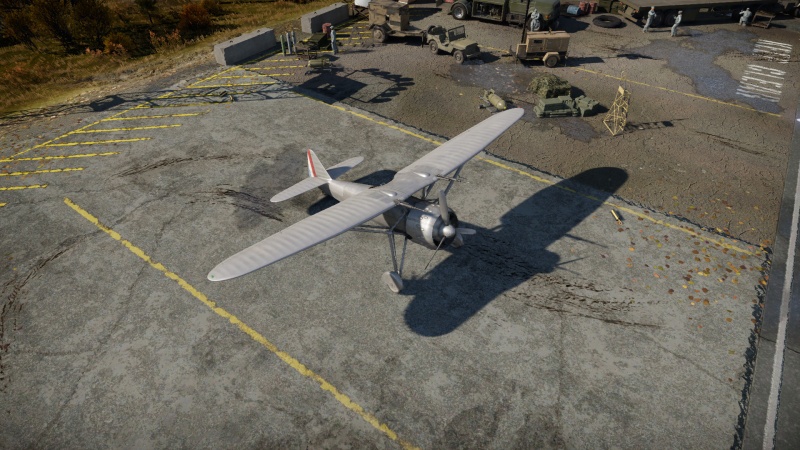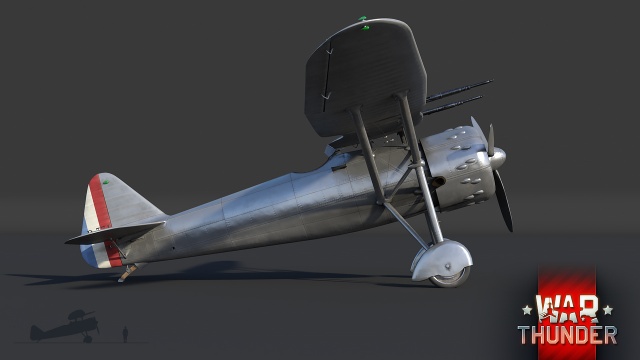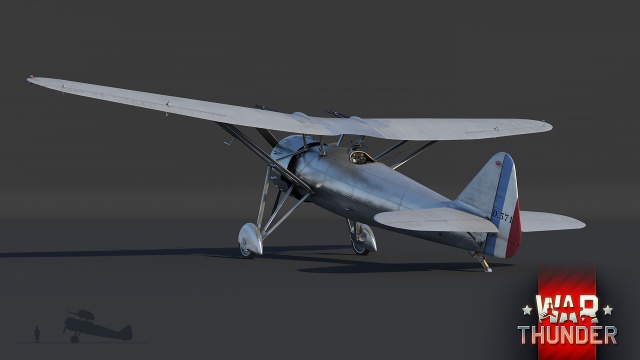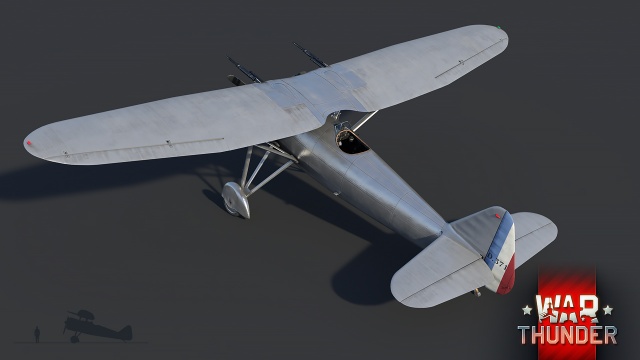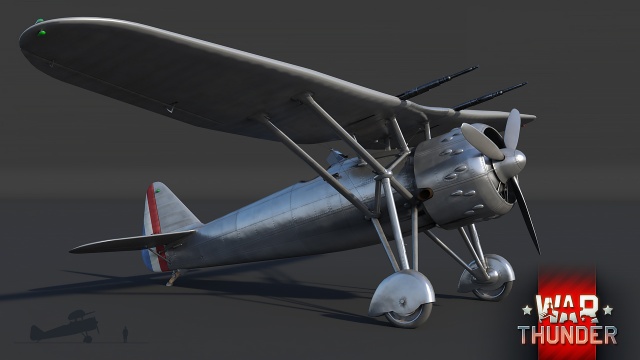Difference between revisions of "D.371 H.S.9"
(→Details) (Tag: Visual edit) |
Colok76286 (talk | contribs) (→Description: Edits) |
||
| (18 intermediate revisions by 11 users not shown) | |||
| Line 1: | Line 1: | ||
| + | {{About | ||
| + | | about = French fighter '''{{PAGENAME}}''' | ||
| + | | usage = other versions | ||
| + | | link = D.37 (Family) | ||
| + | }} | ||
{{Specs-Card | {{Specs-Card | ||
|code=d_371_hs9 | |code=d_371_hs9 | ||
| + | |images={{Specs-Card-Image|GarageImage_{{PAGENAME}}.jpg|ArtImage_{{PAGENAME}}.png}} | ||
|cockpit = cockpit_d_371_hs9.jpg | |cockpit = cockpit_d_371_hs9.jpg | ||
| − | |||
| − | |||
| − | |||
| − | |||
| − | |||
}} | }} | ||
== Description == | == Description == | ||
<!-- ''In the description, the first part should be about the history of and the creation and combat usage of the aircraft, as well as its key features. In the second part, tell the reader about the aircraft in the game. Insert a screenshot of the vehicle, so that if the novice player does not remember the vehicle by name, he will immediately understand what kind of vehicle the article is talking about.'' --> | <!-- ''In the description, the first part should be about the history of and the creation and combat usage of the aircraft, as well as its key features. In the second part, tell the reader about the aircraft in the game. Insert a screenshot of the vehicle, so that if the novice player does not remember the vehicle by name, he will immediately understand what kind of vehicle the article is talking about.'' --> | ||
| − | + | The '''{{Specs|name}}''' is a premium gift rank {{Specs|rank}} French fighter {{Battle-rating}}. It was introduced as a [[wt:en/news/5008-news-french-aircraft-in-update-1-73-en|premium pack]] in [[Update 1.73 "Vive la France"]] and was discontinued from the store after the [[wt:en/news/5488-shop-victory-day-allied-bundles-and-discounts-en|2018 Victory Day sale]]. It was a reward vehicle for the [[wt:en/news/6442-special-war-thunder-reaches-its-7th-year-en|War Thunder's 7th Anniversary]] and [[wt:en/news/7945-special-happy-anniversary-war-thunder-en|War Thunder's 10th Anniversary]] events. | |
| − | |||
| − | The '''{{Specs|name}}''' is a gift rank {{Specs|rank}} French fighter {{Battle-rating}}. It was introduced in [[Update 1.73 "Vive la France"]]. | ||
| − | The D.371 H.S.9 is a modification of the first production aircraft of the D.37 series. The D.371 H.S.9 (along with its siblings D.371 and D.373) are unique compared to other early aircraft in the game as it is a monoplane with a parasol wing as opposed to other low-wing monoplanes and biplanes. Key features of this version include 2 x Hispano-Suiza 9 20 mm cannons which are a rare find on aircraft this low in rank. | + | The D.371 H.S.9 is a modification of the first production aircraft of the D.37 series. The D.371 H.S.9 (along with its siblings D.371 and D.373) are unique compared to other early aircraft in the game as it is a monoplane with a parasol wing as opposed to other low-wing monoplanes and biplanes. Key features of this version include 2 x Hispano-Suiza 9 20 mm cannons, which are a rare find on aircraft this low in rank. |
| − | This aircraft is the first of the D.37 series featured in the game along with its younger sibling the D.373. As a single-engine monoplane, it is agile and quick and while it can be a formidable turn-fighter, maintaining speed in this aircraft is crucial, or else it becomes a slow easy target for other aircraft. The H.S.9 cannons are very powerful, especially against early aircraft, many of which utilised cloth coverings and wooden frames. Tempting as it is to unload the weapons on the enemy in front of you, the ammunition load carried in the aircraft is a paltry 30 rounds per gun (60 rounds total). A careful aim and conservation of ammunition are vital with this aircraft. | + | This aircraft is the first of the D.37 series featured in the game, along with its younger sibling the D.373. As a single-engine monoplane, it is agile and quick and while it can be a formidable turn-fighter, maintaining speed in this aircraft is crucial, or else it becomes a slow easy target for other aircraft. The H.S.9 cannons are very powerful, especially against early aircraft, many of which utilised cloth coverings and wooden frames. Tempting as it is to unload the weapons on the enemy in front of you, the ammunition load carried in the aircraft is a paltry 30 rounds per gun (60 rounds total). A careful aim and conservation of ammunition are vital with this aircraft. |
| − | Due to the D.371 H.S.9 being a low-rank aircraft, it is not uncommon for it to be pitted against higher rank I aircraft and even some lower rank II planes too. While slower than many of the higher aircraft it may face, not all is lost. The D.371 H.S.9 will have a manoeuvrability advantage and most likely a weapons advantage, so the pilot must cause the enemy to fight on their terms where the cannons have a chance to blow holes in the enemies engines, fuel tanks or even the pilot! | + | Due to the D.371 H.S.9 being a low-rank aircraft, it is not uncommon for it to be pitted against higher rank I aircraft and even some lower rank II planes too. While slower than many of the higher aircraft it may face, not all is lost. The D.371 H.S.9 will have a manoeuvrability advantage and most likely a weapons advantage, so the pilot must cause the enemy to fight on their terms where the cannons have a chance to blow holes in the enemies engines, fuel tanks or even the pilot! Don't underestimate D.371 H.S.9 as it can be considered the gun which is brought to a knife fight! |
== General info == | == General info == | ||
=== Flight performance === | === Flight performance === | ||
| − | ''Describe how the aircraft behaves in the air. Speed, manoeuvrability, acceleration and allowable loads - these are the most important characteristics of the vehicle.'' | + | {{Specs-Avia-Flight}} |
| + | <!-- ''Describe how the aircraft behaves in the air. Speed, manoeuvrability, acceleration and allowable loads - these are the most important characteristics of the vehicle.'' --> | ||
| − | {| class="wikitable" style="text-align:center" | + | {| class="wikitable" style="text-align:center" width="70%" |
! rowspan="2" | Characteristics | ! rowspan="2" | Characteristics | ||
! colspan="2" | Max Speed<br>(km/h at 5,000 m) | ! colspan="2" | Max Speed<br>(km/h at 5,000 m) | ||
| − | ! rowspan="2" | Max altitude<br>( | + | ! rowspan="2" | Max altitude<br>(metres) |
! colspan="2" | Turn time<br>(seconds) | ! colspan="2" | Turn time<br>(seconds) | ||
| − | ! colspan="2" | Rate of climb<br>( | + | ! colspan="2" | Rate of climb<br>(metres/second) |
| − | ! rowspan="2" | Take-off run<br>( | + | ! rowspan="2" | Take-off run<br>(metres) |
|- | |- | ||
! AB !! RB !! AB !! RB !! AB !! RB | ! AB !! RB !! AB !! RB !! AB !! RB | ||
|- | |- | ||
! Stock | ! Stock | ||
| − | | | + | | 384 || 368 || rowspan="2" | {{Specs|ceiling}} || 13.8 || 14.4 || 9.7 || 9.7 || rowspan="2" | 150 |
|- | |- | ||
! Upgraded | ! Upgraded | ||
| − | | | + | | 419 || 400 || 12.5 || 13.0 || 20.0 || 14.0 |
|- | |- | ||
|} | |} | ||
==== Details ==== | ==== Details ==== | ||
| − | {| class="wikitable" style="text-align:center" | + | {| class="wikitable" style="text-align:center" width="50%" |
|- | |- | ||
| − | ! colspan=" | + | ! colspan="5" | Features |
|- | |- | ||
| − | ! Combat flaps !! Take-off flaps !! Landing flaps !! Air brakes !! Arrestor gear | + | ! Combat flaps !! Take-off flaps !! Landing flaps !! Air brakes !! Arrestor gear |
|- | |- | ||
| − | | X || X || | + | | X || X || ✓ || X || X <!-- ✓ --> |
|- | |- | ||
|} | |} | ||
| − | {| class="wikitable" style="text-align:center" | + | {| class="wikitable" style="text-align:center" width="50%" |
|- | |- | ||
! colspan="7" | Limits | ! colspan="7" | Limits | ||
| Line 65: | Line 65: | ||
! Combat !! Take-off !! Landing !! + !! - | ! Combat !! Take-off !! Landing !! + !! - | ||
|- | |- | ||
| − | |{{Specs| | + | | {{Specs|destruction|body}} || {{Specs|destruction|gear}} || N/A || N/A || 240 || ~12 || ~6 |
|- | |- | ||
|} | |} | ||
| Line 92: | Line 92: | ||
=== Survivability and armour === | === Survivability and armour === | ||
| + | {{Specs-Avia-Armour}} | ||
<!-- ''Examine the survivability of the aircraft. Note how vulnerable the structure is and how secure the pilot is, whether the fuel tanks are armoured, etc. Describe the armour, if there is any, and also mention the vulnerability of other critical aircraft systems.'' --> | <!-- ''Examine the survivability of the aircraft. Note how vulnerable the structure is and how secure the pilot is, whether the fuel tanks are armoured, etc. Describe the armour, if there is any, and also mention the vulnerability of other critical aircraft systems.'' --> | ||
Early aircraft did not feature much in the way of armour protection as many of the aircraft at this point were transitioning from the wood frame and cloth skin to the wood frame and metal skinned aircraft. Due to the balancing of the aircraft, much of the critical equipment was positioned towards the front of the aircraft, where the engine, fuel tanks, oil pumps, control linkages and the pilot were clustered around each other. With this tight grouping and no armour protection, when fired upon, chances were high to hit a critical component in the aircraft. | Early aircraft did not feature much in the way of armour protection as many of the aircraft at this point were transitioning from the wood frame and cloth skin to the wood frame and metal skinned aircraft. Due to the balancing of the aircraft, much of the critical equipment was positioned towards the front of the aircraft, where the engine, fuel tanks, oil pumps, control linkages and the pilot were clustered around each other. With this tight grouping and no armour protection, when fired upon, chances were high to hit a critical component in the aircraft. | ||
| − | The key to survival is to keep moving (avoid flying in straight lines and always be looking around) along with being aware of your surroundings, if you start hearing bullets or see tracer fire whizzing by, it may be too late and the pilot will need to take evasive action to avoid being shot down. | + | The key to survival is to keep moving (avoid flying in straight lines and always be looking around) along with being aware of your surroundings, if you start hearing bullets or see tracer fire whizzing by, it may be too late, and the pilot will need to take evasive action to avoid being shot down. |
| + | |||
| + | === Modifications and economy === | ||
| + | {{Specs-Economy}} | ||
== Armaments == | == Armaments == | ||
| + | {{Specs-Avia-Armaments}} | ||
=== Offensive armament === | === Offensive armament === | ||
| + | {{Specs-Avia-Offensive}} | ||
<!-- ''Describe the offensive armament of the aircraft, if any. Describe how effective the cannons and machine guns are in a battle, and also what belts or drums are better to use. If there is no offensive weaponry, delete this subsection.'' --> | <!-- ''Describe the offensive armament of the aircraft, if any. Describe how effective the cannons and machine guns are in a battle, and also what belts or drums are better to use. If there is no offensive weaponry, delete this subsection.'' --> | ||
{{main|Hispano HS.9 (20 mm)}} | {{main|Hispano HS.9 (20 mm)}} | ||
| Line 107: | Line 113: | ||
* 2 x 20 mm Hispano HS.9 cannons, wing-mounted (30 rpg = 60 total) | * 2 x 20 mm Hispano HS.9 cannons, wing-mounted (30 rpg = 60 total) | ||
| − | Each of the two cannons are located with one on each side of the fuselage, mounted to the underside of the wing. Each cannon is outfitted with the same amount of ammunition, which means that both guns will fire together until empty. Due to the mounting locations on the wings (just outside | + | Each of the two cannons are located with one on each side of the fuselage, mounted to the underside of the wing. Each cannon is outfitted with the same amount of ammunition, which means that both guns will fire together until empty. Due to the mounting locations on the wings (just outside the propeller arc), convergence in this aircraft is not as critical, but still necessary. Most of the fighting with this aircraft will be in close quarters to exploit the explosive power of the cannons in close range. Convergence set between 150 and 300 m (wherever you are most comfortable) will work best along with careful aim to put the most bullets into the enemy aircraft as possible and hit a critical component. Many pilots in World War I and II would set their weapon's convergence to 200 to 250 m and would wait until being in that range before firing to ensure best chances for shooting down the enemy. Shots from too far away could "spook" the enemy into evasive manoeuvres or just waste ammunition in a "spray and pray" manoeuvre, which one cannot afford with this aircraft. Practice and skill will allow the pilot to close within 250 m of the enemy and take them out with controlled bursts, and then move onto the next victim. |
== Usage in battles == | == Usage in battles == | ||
<!-- ''Describe the tactics of playing in the aircraft, the features of using aircraft in a team and advice on tactics. Refrain from creating a "guide" - do not impose a single point of view, but instead, give the reader food for thought. Examine the most dangerous enemies and give recommendations on fighting them. If necessary, note the specifics of the game in different modes (AB, RB, SB).'' --> | <!-- ''Describe the tactics of playing in the aircraft, the features of using aircraft in a team and advice on tactics. Refrain from creating a "guide" - do not impose a single point of view, but instead, give the reader food for thought. Examine the most dangerous enemies and give recommendations on fighting them. If necessary, note the specifics of the game in different modes (AB, RB, SB).'' --> | ||
| − | Maintaining speed with this aircraft is a must as a slow D.371 is an easy target. Initial spawning into a map should lead a D.371 pilot to climb and gain altitude. This will give you an advantage over most other pilots upon reaching the combat area as you will be able to select which enemy plane to dive on and attack. With a diving attack, you will gain speed which | + | Maintaining speed with this aircraft is a must, as a slow D.371 is an easy target. Initial spawning into a map should lead a D.371 pilot to climb and gain altitude. This will give you an advantage over most other pilots upon reaching the combat area, as you will be able to select which enemy plane to dive on and attack. With a diving attack, you will gain speed which allows you to quickly gain on the enemy aircraft to fire off a burst of rounds and then climb back up to altitude. Only fire when you are sure to hit. If you decide to tail an enemy plane after a dive, you will risk bleeding off your energy. When attacking an enemy plane, attempt to attack when you see the greatest surface area of the fuselage and wings. If tailing a fighter, wait for them to turn or pull-up to expose the most surface area. When turn fighting or looping, utilise your rudder to sharpen your turning ability. |
=== Manual Engine Control === | === Manual Engine Control === | ||
| Line 127: | Line 133: | ||
|- | |- | ||
| Controllable || Not controllable<br>Not auto controlled || Not controllable<br>Not auto controlled || Not controllable<br>Not auto controlled || Separate || Not controllable<br>1 gear || Not controllable | | Controllable || Not controllable<br>Not auto controlled || Not controllable<br>Not auto controlled || Not controllable<br>Not auto controlled || Separate || Not controllable<br>1 gear || Not controllable | ||
| − | |||
| − | |||
| − | |||
| − | |||
| − | |||
| − | |||
| − | |||
| − | |||
| − | |||
| − | |||
| − | |||
| − | |||
| − | |||
| − | |||
| − | |||
| − | |||
| − | |||
| − | |||
| − | |||
| − | |||
| − | |||
| − | |||
| − | |||
| − | |||
| − | |||
| − | |||
| − | |||
| − | |||
| − | |||
| − | |||
| − | |||
| − | |||
| − | |||
| − | |||
| − | |||
|- | |- | ||
|} | |} | ||
| Line 188: | Line 159: | ||
== History == | == History == | ||
<!-- ''Describe the history of the creation and combat usage of the aircraft in more detail than in the introduction. If the historical reference turns out to be too long, take it to a separate article, taking a link to the article about the vehicle and adding a block "/History" (example: <nowiki>https://wiki.warthunder.com/(Vehicle-name)/History</nowiki>) and add a link to it here using the <code>main</code> template. Be sure to reference text and sources by using <code><nowiki><ref></ref></nowiki></code>, as well as adding them at the end of the article with <code><nowiki><references /></nowiki></code>. This section may also include the vehicle's dev blog entry (if applicable) and the in-game encyclopedia description (under <code><nowiki>=== In-game description ===</nowiki></code>, also if applicable).'' --> | <!-- ''Describe the history of the creation and combat usage of the aircraft in more detail than in the introduction. If the historical reference turns out to be too long, take it to a separate article, taking a link to the article about the vehicle and adding a block "/History" (example: <nowiki>https://wiki.warthunder.com/(Vehicle-name)/History</nowiki>) and add a link to it here using the <code>main</code> template. Be sure to reference text and sources by using <code><nowiki><ref></ref></nowiki></code>, as well as adding them at the end of the article with <code><nowiki><references /></nowiki></code>. This section may also include the vehicle's dev blog entry (if applicable) and the in-game encyclopedia description (under <code><nowiki>=== In-game description ===</nowiki></code>, also if applicable).'' --> | ||
| + | |||
In the early 1930s, SAF-Avions Dewoitine, a French aircraft manufacturing company, developed the D.37 aircraft, a single-seat aeroplane with a parasol wing, radial engine, fixed landing gear and a tail-skid; however, the actual manufacturing of the aircraft was transferred to Lioré et Olivier. | In the early 1930s, SAF-Avions Dewoitine, a French aircraft manufacturing company, developed the D.37 aircraft, a single-seat aeroplane with a parasol wing, radial engine, fixed landing gear and a tail-skid; however, the actual manufacturing of the aircraft was transferred to Lioré et Olivier. | ||
| Line 193: | Line 165: | ||
== Media == | == Media == | ||
| − | <!--Excellent additions to the article would be video guides, screenshots from the game, and photos.--> | + | <!-- ''Excellent additions to the article would be video guides, screenshots from the game, and photos.'' --> |
| + | |||
| + | ;Skins | ||
| + | |||
| + | * [https://live.warthunder.com/feed/camouflages/?vehicle=d_371_hs9 Skins and camouflages for the {{PAGENAME}} from live.warthunder.com.] | ||
;Images | ;Images | ||
<gallery mode="packed-hover"> | <gallery mode="packed-hover"> | ||
| − | Image:d_371_WT_poster1.jpg|<small>D.371 H.S.9 - Right side view | + | Image:d_371_WT_poster1.jpg|<small>D.371 H.S.9 - Right side view</small> |
| − | Image:d_371_WT_poster2.jpg|<small>D.371 H.S.9 - Left side view | + | Image:d_371_WT_poster2.jpg|<small>D.371 H.S.9 - Left side view</small> |
| − | Image:d_371_WT_poster3.jpg|<small>D.371 H.S.9 - Upper left side view | + | Image:d_371_WT_poster3.jpg|<small>D.371 H.S.9 - Upper left side view</small> |
| − | Image:d_371_WT_poster4.jpg|<small>D.371 H.S.9 - Right front side view | + | Image:d_371_WT_poster4.jpg|<small>D.371 H.S.9 - Right front side view</small> |
</gallery> | </gallery> | ||
;Videos | ;Videos | ||
| − | {{Youtube-gallery|val2qd1RsNY|'''The Shooting Range #69''' - ''War Machines'' section at 00:25 discusses the | + | {{Youtube-gallery|gcsLTpQHsMM|'''{{PAGENAME}} - Hit and Miss''' - ''Oxy''|SCy9mj6YFQI|'''(Arcade): {{PAGENAME}} - The Cannon Conundrum''' - ''tx141TX'' (Review starts at 3:51)|val2qd1RsNY|'''The Shooting Range #69''' - ''War Machines'' section at 00:25 discusses the {{PAGENAME}}.}} |
== See also == | == See also == | ||
| Line 210: | Line 186: | ||
* ''reference to the series of the aircraft;'' | * ''reference to the series of the aircraft;'' | ||
* ''links to approximate analogues of other nations and research trees.'' --> | * ''links to approximate analogues of other nations and research trees.'' --> | ||
| + | |||
| + | ;[[D.37 (Family)|Family development]] | ||
| + | |||
| + | * [[D.371]] - Initial production variant of the aircraft with machine gun armaments | ||
| + | * [[D.373]] - Navalised variant of the aircraft | ||
| + | |||
| + | ;Similar vehicles in other nations | ||
* [[I-153P]] - Another pre-war design that was upgraded with cannon armament. | * [[I-153P]] - Another pre-war design that was upgraded with cannon armament. | ||
| Line 216: | Line 199: | ||
<!-- ''Paste links to sources and external resources, such as:'' | <!-- ''Paste links to sources and external resources, such as:'' | ||
* ''topic on the official game forum;'' | * ''topic on the official game forum;'' | ||
| − | |||
* ''other literature.'' --> | * ''other literature.'' --> | ||
| − | * [ | + | * [[wt:en/news/5008-news-french-aircraft-in-update-1-73-en|[News] French aircraft in update 1.73!]] |
| − | * [ | + | * [[wt:en/news/5048-development-dewoitine-d-371-aerial-trickster-en|[Devblog] Dewoitine D.371: Aerial Trickster]] |
| + | * [https://forum.warthunder.com/index.php?/topic/385694-dewoitine-d-37x/ Official data sheet - more details about the performance] | ||
{{AirManufacturer Dewoitine}} | {{AirManufacturer Dewoitine}} | ||
{{France fighters}} | {{France fighters}} | ||
{{France premium aircraft}} | {{France premium aircraft}} | ||
Latest revision as of 21:25, 8 November 2022
| This page is about the French fighter D.371 H.S.9. For other versions, see D.37 (Family). |
Contents
Description
The D.371 H.S.9 is a premium gift rank I French fighter with a battle rating of 1.7 (AB) and 1.3 (RB/SB). It was introduced as a premium pack in Update 1.73 "Vive la France" and was discontinued from the store after the 2018 Victory Day sale. It was a reward vehicle for the War Thunder's 7th Anniversary and War Thunder's 10th Anniversary events.
The D.371 H.S.9 is a modification of the first production aircraft of the D.37 series. The D.371 H.S.9 (along with its siblings D.371 and D.373) are unique compared to other early aircraft in the game as it is a monoplane with a parasol wing as opposed to other low-wing monoplanes and biplanes. Key features of this version include 2 x Hispano-Suiza 9 20 mm cannons, which are a rare find on aircraft this low in rank.
This aircraft is the first of the D.37 series featured in the game, along with its younger sibling the D.373. As a single-engine monoplane, it is agile and quick and while it can be a formidable turn-fighter, maintaining speed in this aircraft is crucial, or else it becomes a slow easy target for other aircraft. The H.S.9 cannons are very powerful, especially against early aircraft, many of which utilised cloth coverings and wooden frames. Tempting as it is to unload the weapons on the enemy in front of you, the ammunition load carried in the aircraft is a paltry 30 rounds per gun (60 rounds total). A careful aim and conservation of ammunition are vital with this aircraft.
Due to the D.371 H.S.9 being a low-rank aircraft, it is not uncommon for it to be pitted against higher rank I aircraft and even some lower rank II planes too. While slower than many of the higher aircraft it may face, not all is lost. The D.371 H.S.9 will have a manoeuvrability advantage and most likely a weapons advantage, so the pilot must cause the enemy to fight on their terms where the cannons have a chance to blow holes in the enemies engines, fuel tanks or even the pilot! Don't underestimate D.371 H.S.9 as it can be considered the gun which is brought to a knife fight!
General info
Flight performance
| Characteristics | Max Speed (km/h at 5,000 m) |
Max altitude (metres) |
Turn time (seconds) |
Rate of climb (metres/second) |
Take-off run (metres) | |||
|---|---|---|---|---|---|---|---|---|
| AB | RB | AB | RB | AB | RB | |||
| Stock | 384 | 368 | 9000 | 13.8 | 14.4 | 9.7 | 9.7 | 150 |
| Upgraded | 419 | 400 | 12.5 | 13.0 | 20.0 | 14.0 | ||
Details
| Features | ||||
|---|---|---|---|---|
| Combat flaps | Take-off flaps | Landing flaps | Air brakes | Arrestor gear |
| X | X | ✓ | X | X |
| Limits | ||||||
|---|---|---|---|---|---|---|
| Wings (km/h) | Gear (km/h) | Flaps (km/h) | Max Static G | |||
| Combat | Take-off | Landing | + | - | ||
| 560 | 560 | N/A | N/A | 240 | ~12 | ~6 |
| Optimal velocities (km/h) | |||
|---|---|---|---|
| Ailerons | Rudder | Elevators | Radiator |
| < 240 | < 220 | < 260 | > 210 |
| Compressor | Optimal altitude | 100% Engine power | WEP Engine power |
|---|---|---|---|
| Setting 1 | 3,825 m | 880 hp | 1,023 hp |
Survivability and armour
Early aircraft did not feature much in the way of armour protection as many of the aircraft at this point were transitioning from the wood frame and cloth skin to the wood frame and metal skinned aircraft. Due to the balancing of the aircraft, much of the critical equipment was positioned towards the front of the aircraft, where the engine, fuel tanks, oil pumps, control linkages and the pilot were clustered around each other. With this tight grouping and no armour protection, when fired upon, chances were high to hit a critical component in the aircraft.
The key to survival is to keep moving (avoid flying in straight lines and always be looking around) along with being aware of your surroundings, if you start hearing bullets or see tracer fire whizzing by, it may be too late, and the pilot will need to take evasive action to avoid being shot down.
Modifications and economy
Armaments
Offensive armament
The D.371 H.S.9 is armed with:
- 2 x 20 mm Hispano HS.9 cannons, wing-mounted (30 rpg = 60 total)
Each of the two cannons are located with one on each side of the fuselage, mounted to the underside of the wing. Each cannon is outfitted with the same amount of ammunition, which means that both guns will fire together until empty. Due to the mounting locations on the wings (just outside the propeller arc), convergence in this aircraft is not as critical, but still necessary. Most of the fighting with this aircraft will be in close quarters to exploit the explosive power of the cannons in close range. Convergence set between 150 and 300 m (wherever you are most comfortable) will work best along with careful aim to put the most bullets into the enemy aircraft as possible and hit a critical component. Many pilots in World War I and II would set their weapon's convergence to 200 to 250 m and would wait until being in that range before firing to ensure best chances for shooting down the enemy. Shots from too far away could "spook" the enemy into evasive manoeuvres or just waste ammunition in a "spray and pray" manoeuvre, which one cannot afford with this aircraft. Practice and skill will allow the pilot to close within 250 m of the enemy and take them out with controlled bursts, and then move onto the next victim.
Usage in battles
Maintaining speed with this aircraft is a must, as a slow D.371 is an easy target. Initial spawning into a map should lead a D.371 pilot to climb and gain altitude. This will give you an advantage over most other pilots upon reaching the combat area, as you will be able to select which enemy plane to dive on and attack. With a diving attack, you will gain speed which allows you to quickly gain on the enemy aircraft to fire off a burst of rounds and then climb back up to altitude. Only fire when you are sure to hit. If you decide to tail an enemy plane after a dive, you will risk bleeding off your energy. When attacking an enemy plane, attempt to attack when you see the greatest surface area of the fuselage and wings. If tailing a fighter, wait for them to turn or pull-up to expose the most surface area. When turn fighting or looping, utilise your rudder to sharpen your turning ability.
Manual Engine Control
| MEC elements | ||||||
|---|---|---|---|---|---|---|
| Mixer | Pitch | Radiator | Supercharger | Turbocharger | ||
| Oil | Water | Type | ||||
| Controllable | Not controllable Not auto controlled |
Not controllable Not auto controlled |
Not controllable Not auto controlled |
Separate | Not controllable 1 gear |
Not controllable |
Pros and cons
Pros:
- Very manoeuvrable
- Roll rate is above average
- Adequate climb rate for rank I fighter
- A smaller target compared to most biplanes
- 2 x 20 mm Hispano HS.9 cannons
- Effective against bombers
- Use stealth belt against biplanes with devastating results
Cons:
- Most rivals are faster at this point
- Out-turned by biplanes
- Continuous firing of cannons results in aircraft pulling up
- Weak structure
- Low ammo count
History
In the early 1930s, SAF-Avions Dewoitine, a French aircraft manufacturing company, developed the D.37 aircraft, a single-seat aeroplane with a parasol wing, radial engine, fixed landing gear and a tail-skid; however, the actual manufacturing of the aircraft was transferred to Lioré et Olivier.
The D.371 H.S.9 was a modification of the first production version of the D.37 aircraft line to equip 20 mm cannons.
Media
- Skins
- Images
- Videos
See also
- D.371 - Initial production variant of the aircraft with machine gun armaments
- D.373 - Navalised variant of the aircraft
- Similar vehicles in other nations
- I-153P - Another pre-war design that was upgraded with cannon armament.
External links
- [News] French aircraft in update 1.73!
- [Devblog] Dewoitine D.371: Aerial Trickster
- Official data sheet - more details about the performance
| Dewoitine (SNCAM/SNCASE) | |
|---|---|
| Fighters | |
| D.37 | D.371 · D.371 H.S.9 · D.373 |
| D.500 | D.500 · D.501 · Pallier's D.510 |
| D.520 | D.520 · ▄D.520 · ▄D.521 |
| Export | ␗D.510C |
| France fighters | |
|---|---|
| Dewoitine | D.371 · D.371 H.S.9 · D.373 · D.500 · D.501 · Pallier's D.510 · D.520 |
| Morane-Saulnier | M.S.405C1 · M.S.406C1 · M.S.410 |
| Arsenal | V.G.33C-1 |
| Bloch | M.B.152C1 · M.B.157 |
| Caudron | C.R.714 |
| Sud-Ouest | S.O.8000 Narval |
| American | H-75A-1 · H-75A-4 · ▄P-39Q-25 · ▄P-40F-5 Lafayette · ▄P-47D-22-RE · ▄P-63C-5 · F-6C-10-NA |
| ▄F6F-5 · ▄F6F-5N · F4U-7 · ▄F8F-1B | |
| Other countries | ▄Seafire LF Mk.III · ▄Yak-3 · Challe's ▄Yak-9T · NC.900 |
| Belgium | ▄Gladiator Mk I · ▄Spitfire FR Mk XIVe |
| Netherlands | ◘Sea Fury FB 51 |
| France premium aircraft | |
|---|---|
| Fighters | D.371 H.S.9 · Pallier's D.510 · ▄P-39Q-25 · ▄P-40F-5 Lafayette · ▄P-47D-22-RE · F-6C-10-NA |
| M.B.152C1 · ▄Yak-3 · Challe's ▄Yak-9T · NC.900 · S.O.8000 Narval | |
| Jet fighters | ◘Sea Hawk Mk.50 · Milan · Mirage F1C-200 |
| Strike aircraft | ▄AD-4NA · F-84F IAF |
| Bombers | Late 298D · ▄PBY-5A Late |
| Jet bombers | Vautour IIA IDF/AF · S.O.4050 Vautour IIN |


